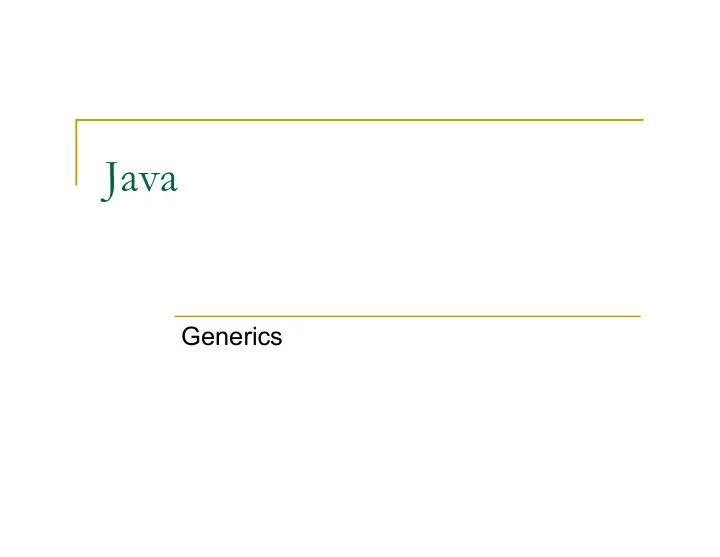

Java Generics
Generics n Since JDK 1.5 (Java 5), the Collections framework has been parameterized. n A class that is defined with a parameter for a type is called a generic or a parameterized class. In C++, there were referred to as template classes. n If you compare the Collection interface in the API for 1.4.2 to the one in version 1.5.0, you will see the interface is now called Collection<E>. 2
Collection <E> Interface n The E represents a type and allows the user to create a homogenous collection of objects. n Using the parameterized collection or type, allows the user to retrieve objects from the collection without having to cast them. Before: After: List c = new ArrayList(); List<Integer> c = new ArrayList<Integer>(); c.add(new Integer(34)); c.add(new Integer(34)); Integer i = (Integer) c.get(0); Integer i = c.get(0); 3
Generic Cell Example public class CellDemo { public static void main (String[ ] args) { // define a cell for Integers Cell<Integer> intCell = new Cell<Integer>( new Integer(5) ); // define a cell for Floats Cell<Float> floatCell = new Cell<Float>( new Float(6.7) ); // compiler error if we remove a Float from Integer Cell Float t = (Float)intCell.getPrisoner( ); System.out.println(t); } } class Cell< T > { private T prisoner; public Cell( T p) { prisoner = p; } public T getPrisoner(){return prisoner; } } 4
Dont ’ s of Generic Programming n Like C++, you CANNOT use a parameter in a constructor. T obj = new T(); T [] array = new T[5]; n Like C++, you CANNOT create an array of a generic type. Collection <Integer> c[ ] = new Collection<Integer>[10]; 5 �
Do ’ s of Generic Programming n The type parameter must always represent a reference data type. n Class name in a parameterized class definition has a type parameter attached. class Cell<T> n The type parameter is not used in the header of the constructor. public Cell( ) n Angular brackets are not used if the type parameter is the type for a parameter of the constructor. public Cell3(T prisoner ); n However, when a generic class is instantiated, the angular brackets are used List<Integer> c = new ArrayList<Integer>(); 6
Bounding the Type n You will see in the API a type parameter defined as follows <? extends E>. This restricts the parameter to representing only data types that implement E, i.e. subclasses of E boolean addAll(Collection<? extends E> c) � 7 �
Bounding Type Parameters n The following restricts the possible types that can be plugged in for a type parameter T. public class RClass<T extends Comparable> n " extends Comparable " serves as a bound on the type parameter T. n Any attempt to plug in a type for T which does not implement the Comparable interface results in a compiler error message 8
More Bounding n In the API, several collection classes contain <? super T> in the constructor. This bounds the parameter type to any class that is a supertype of T. interface Comparator<T> { int compare(T fst, T snd); } TreeSet(Comparator<? super E> c) 9
Generic Sorting public class Sort { public static <T extends Comparable<T>> void bubbleSort(T[] a) { for (int i = 0; i< a.length - 1; i++) for (int j = 0; j < a.length -1 - i; j++) if (a[j+1].compareTo(a[j]) < 0) { T tmp = a[j]; a[j] = a[j+1]; a[j+1] = tmp; } } } 10
Generic Sorting (cont.) n Given the following: class Animal implements Comparable<Animal> { ...} class Dog extends Animal { ... } class Cat extends Animal { ... } n Now we should be able to sort dogs if contains the compareTo method which compares animals by weight. n BUT … bubblesort only sorts objects of type T which extend T. Here the super class implements Comparable. n New and improved sort on next page can handle sorting Dogs and Cats. 11
Generic Sorting (cont.) public class Sort { public static <T extends Comparable<? super T>> void bubbleSort(T[] a) { for (int i = 0; i< a.length - 1; i++) for (int j = 0; j < a.length -1 - i; j++) if (a[j+1].compareTo(a[j]) < 0) { T tmp = a[j]; a[j] = a[j+1]; a[j+1] = tmp; } } } 12
Recommend
More recommend